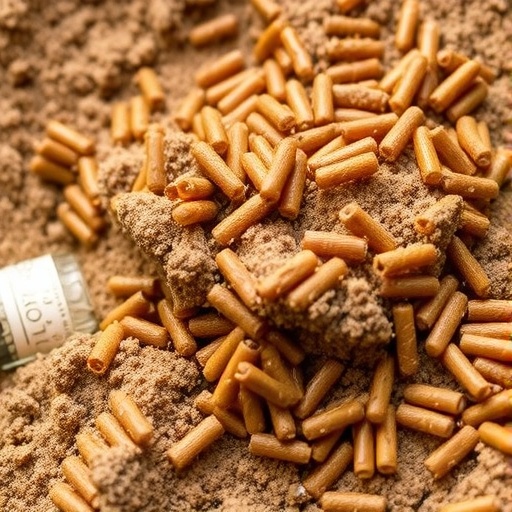In an extraordinary expedition into the intricate microcosm of the digestive systems of Namibia’s herbivorous wildlife, researchers have unveiled compelling insights about the gut microbiomes of elephants, giraffes, and other grazers inhabiting Etosha National Park. This study transcends conventional ecological research by illuminating how environmental conditions, biological sex, and anatomical diversities collectively orchestrate the microbial populations within these species. Given the pivotal role these microbiomes play in overall animal health, these findings promise significant implications for conservation biology, especially in light of recent ecological disturbances such as wildfires that have ravaged the park.
Etosha National Park, with its varied rainfall zones, presents a natural laboratory unparalleled in its capacity to reveal the intricate connections between habitat and gut microbiome diversity. The park was methodically divided into three discrete zones characterized by differing precipitation levels, which in turn affected the flora accessible to herbivores. This environmental gradient formed a foundational element for examining how external variables shape microbial communities residing within the gut ecosystems of these large plant-eaters.
The research team embarked on an ambitious field study, successfully collecting 312 fresh fecal samples from eleven herbivore species spanning from majestic African elephants (Loxodonta africana) and Angolan giraffes (Giraffa camelopardalis angolensis) to a spectrum of antelopes, zebras, and wildebeests. The sampling strategy was designed to capture interspecies as well as intraspecies variations across the diverse environmental conditions present within Etosha.
Applying advanced DNA extraction and sequencing techniques, the team delved deep into characterizing the bacterial constituents of each sample. This molecular approach transcended traditional microbial culturing, allowing for an exhaustive profiling of bacteria that predominate or uniquely inhabit each species’ gut microbiome. The precision of this methodology enabled researchers to generate high-resolution insights comparable to those usually attainable only in captive or clinical settings.
A standout discovery of the analysis was the identification of five bacterial taxa that acted as robust environmental indicators, shifting predictably in abundance across the zones defined by rainfall. These microbes are associated largely with the breakdown of lipids and fibrous plant materials—nutrients critically important to herbivore digestion. Their consistent presence and fluctuation patterns underline the close tie between diet variations driven by environmental factors and gut microbiome configurations.
Among the bacterial groups flagged as environmental indicators is an entire phylum previously documented in the guts of camels, a finding that intrigues scientists given the phylogenetic distance between camels and other Etosha herbivores. This suggests a perhaps universal resilience or adaptive function of this bacterial lineage in arid, water-limited environments, presenting new avenues for understanding microbial ecology under climatic stress.
The study further explored how intrinsic biological variables shape the microbiome landscape. Differences attributable to the biological sex of animals emerged, highlighting that males and females may possess distinct microbial profiles, a nuance often overlooked in wildlife microbiome research. Moreover, gut morphology – an anatomical trait related to digestive strategy – was also found influential, corroborating the hypothesis that internal anatomy critically mediates which microbes establish symbiosis within the digestive tract.
Elephants, in particular, showcased a unique microbial signature with two core bacterial taxa that were relatively absent in other sampled herbivores. The wide-ranging and eclectic diet of elephants likely fosters such distinct microbial populations. This finding is crucial as it underscores how species-specific feeding behaviors directly sculpt gut microbial architecture, with potential consequences for nutrient assimilation and health.
Beyond its scientific merits, this research gains heightened urgency and relevance due to Etosha’s recent wildfire disturbances. With vast areas of the park’s vegetation altered or destroyed, herbivores face a shifting diet that could recalibrate their gut microbiomes drastically. Sampling conducted prior to these fires establishes a vital baseline against which post-fire microbiome adaptations can be measured, thereby informing management strategies aimed at ecosystem recovery and wildlife health monitoring.
The investigation also reinforces the interconnectedness of environmental stressors, dietary shifts, and microbial ecosystems within large mammals. As global climate change exacerbates habitat alterations, such microbiome studies become indispensable for predicting and mitigating impacts on herbivore populations upon which entire ecosystems hinge.
Remarkably, this research fills a critical geographic and taxonomic gap in microbiome literature. By focusing on a suite of large African herbivores in a natural, wild setting, the team provided granular data that enhance understanding of microbiome ecology beyond the more commonly studied domesticated or captive animals. This contribution enriches conservation paradigms with data grounded in real-world complexity.
In sum, the meticulous work carried out in Etosha National Park charts a promising path forward for integrative wildlife conservation. By dovetailing ecological fieldwork with genomic microbiology, it lays the groundwork for adaptive management informed by the subtle yet powerful symbioses between animals, their microbes, and the environment—a triad essential to maintaining biodiversity and ecosystem resilience amidst mounting environmental challenges.
Subject of Research: Animals
Article Title: Interspecific variation in gut microbiome diversity across the Etosha National Park herbivore community
News Publication Date: 9-Oct-2025
Web References: https://journals.plos.org/plosone/article?id=10.1371/journal.pone.0333639
References: McKenney, E., Jensen, R., Lafferty, D., et al. (2025). Interspecific variation in gut microbiome diversity across the Etosha National Park herbivore community. PLOS One. DOI: 10.1371/journal.pone.0333639
Image Credits: James C. Beasley
Keywords: gut microbiome, herbivores, Etosha National Park, elephants, giraffes, microbial ecology, conservation biology, wildfires, DNA sequencing, environmental gradients, gut morphology, animal health
Tags: African wildlife gut microbiomesanimal health and microbiotabiodiversity in herbivoresconservation biology and wildlifeecological research in Namibiaenvironmental impacts on microbiomesEtosha National Park ecosystemgrazers and their habitatsgut health in large mammalsherbivore digestive systemsrainfall effects on flora and faunawildlife conservation strategies





